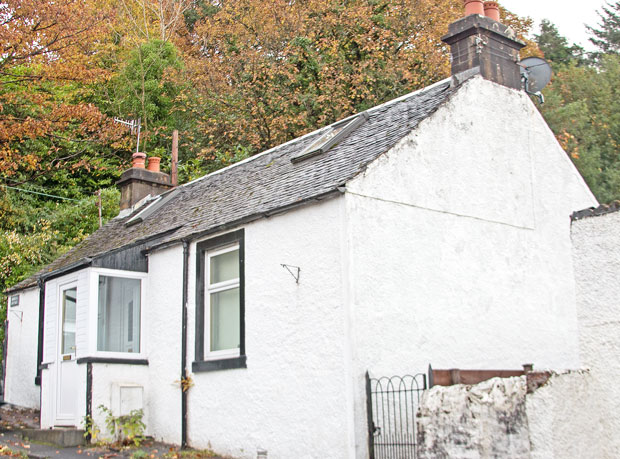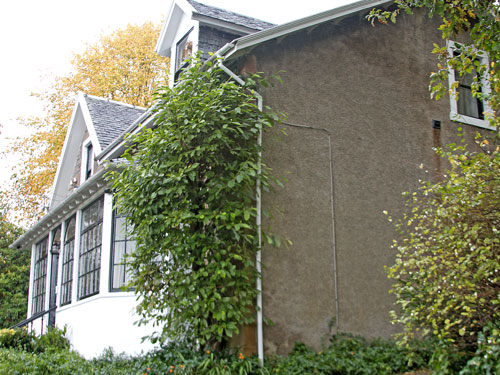FOUR members of a Belgian refugee family spent part of World War One living in Garelochhead.
Now an historical society in their home town in Belgium, Zwijndrecht en Burcht, wants to find out more about them, and if possible find family members who can can supply more information about the stay in Scotland.
Huge numbers of Belgians fled their country at the outbreak of war.
Younger and older people, men and women, the poor and the rich, townspeople as well as country folk, all thronged into roads, stations and ports with the same aim — to flee from the rapidly advancing German troops.
The society's secretary Mireille Schaekers said: “We’re looking into the refugees and other people who ‘weren’t at home’ during the war.
“We know by using the list of Belgian refugees held by the Mitchell Library in Glasgow that four members of the De Meersman family — who lived in Zwijndrecht at Statiestraat 61 — were lodged at Roselea Cottage, Garelochhead.
“The head of this family, Edward, was a ship’s steward who arrived in Glasgow together with his widowed sister Margaret and her two children, Gustave and Hélène.”
Mireille supplied a lot of detail about the family, but the society would like to find out more about their stay on Garelochside, how were they received by local people, whether their arrival was mentioned in the local press, and who was the then owner of the cottage.
Edward De Meersman was born in Burcht, now part of Zwijndrecht, on September 5 1893 and was married in Glasgow on January 12 1910 to Margaret Graham, who was born in Glasgow on August 21 1887.
They had two children while living as lodgers at the Zwijndrecht address before moving to Glasgow late in 1914: Gustave, born in Antwerp on May 18 1911 and Hélène, born in Zwijndrecht on March 23 1913.
They left Glasgow for Hamilton where two other children were born: Rosalie Keith Moffat on May 7 1915 and Gabrielle Emilie on October 21 1918.
 Gustave has always spoken English to his family members, Mireille said, and he described his stay in Scotland as the happiest time of his life.
Gustave has always spoken English to his family members, Mireille said, and he described his stay in Scotland as the happiest time of his life.
After returning to Belgium he never set foot on a ship to work again, but became an employee of the armament factory at Fort Zwijndrecht — less than 2 kilometers away from his house where his granddaughter still lives.
Other known members of the family who came to Scotland were Edward’s mother, Rosalie De Meersman, and other family members Gustave Rosinska, a sailor, Emily Wauters-Rosinka, Jeannie and Marie Rosinka/Wauters.
There were also two families each containing a carpenter, family Helgesen and family Ottoman or Ottomer.
Also living in the same Zwijndrecht home as a lodger was Emile Egide Wauters. He was born in Berchem, now a district of Antwerp, then a village on March 23 1885, and lost his first wife, Johanna Verhas. A sailor by profession, he remarried on September 19 in either 1904 or 1914 to Emilia Rosinska.
Mireille said: “They all seem to be connected by marriage and blood ties. In Antwerp they lived next to each other in Brouwerstraat at nos 25 and 27.”
When Helensburgh Heritage Trust received this unusual request for information recently, director and local historian Alistair McIntyre took up the challenge of finding out what he could.
“This is a very interesting query,” he said. “I was aware of World War One Belgium refugees from several sources.”
Alistair’s researches on the Mitchell Library website found the people mentioned as based at nearby Woodlands, Garelochhead.
They were Rosalie De Meersman, Gustav Rosinla, a seaman, along with children Rosalie, Emily, Jeannie and Marie, John Helgelson, a carpenter, along with wife Marie and children Rosalie and Caroline, and Charles Ottoman, a carpenter, with wife Emina. All the people staying at Roselea and Woodlands were from Antwerp.
The lists also mentioned two people who went to the Queen’s Hotel in Helensburgh, by courtesy of Mr McLellan. They were Frans Van Ceullbroeck. a waiter, and Emmanuel Van Ceullbroeck, a diamond cutter.
The Helensburgh and Gareloch Times for November 11 1914 states that “an exiled band of Belgium refugees found a comfortable home at Woodlands, Garelochhead, which Miss Ferguson has placed at their disposal. They have had many visitors.”
The same edition had a letter about the Belgian refugees, which stated that some were meant to have been accommodated at Ardenconnell in Rhu, but this fell through, owing to the status of the locality as a ‘Prohibited Area’.
The letter went on to make an appeal for contributions in aid of the refugees. But the edition of December 2 1914 reported: “The Belgium group of refugees left last week for other quarters.”
Alistair said: “I’m almost sure I read somewhere that one reason for their departure from this immediate area was that it was considered a sensitive military zone.
“I speculate that the area that they may have moved to might have been the Vale of Leven. I recall my mother’s story about Belgium refugees — she was born in 1907 and brought up in Alexandria.
“She referred to Belgium refugee children in her class at school. One girl she remembered as being stunningly beautiful, with golden hair and lovely blue eyes.”
He checked the ownership of Roselea Cottage. In 1910 and 1918, it was owned by Mrs Margaret Cameron, wife of Angus Cameron, the proprietor of Garelochhead Hotel and the village piermaster.
Mrs Cameron also owned another nearby house called Woodbank, next to Woodlands and up the hill from Roselea Cottage, and several other properties, all of them fairly close to each other.
“It would appear that the owners of both Woodlands and the nearby Woodbank were actively helping the refugees,” he said.
The website www.valeofleven.org.uk has several references to the refugees. It seems that around 500 of them arrived in the Vale in December 1914, and stayed there until December 1918.
It mentions that they were employed in munitions work at the former Argyll Motor Works and a nearby site called ‘The Lyddite’, where munitions were mixed. Both were run by Armstrong Whitworth.
The refugees lived mainly at Govan Drive, Argyll Street, and later, ‘The Huts’, located in part of what is now Argyll Public Park, built to house munition workers but also used to house the Belgian referees.
Alistair said: ”For families living in the cottages, the threat of explosions must surely have been something to think about.”
The website goes on to claim that the Belgians were the one group of immigrants to the Vale who left absolutely no trace of their presence.
But there are plans to list any known names and trades of many of them on the website “in the remote hope that maybe someone in Belgium will one day see the list and get in touch.”
Whether or not the refugees who came initially to Garelochhead had any connection with those in the Vale is not known, but certainly the dates in the Helensburgh and Gareloch Times articles might suggest that.
This is perhaps reinforced by a note in the paper of Christmas Day 1918, that “The Belgium refugees, in the Vale of Leven for most of the war, left for home on Saturday, 130 strong. Most were employed in the Alexandria Munitions Works.”
There were also collections in support of the Belgium Relief Fund, and the paper reported on January 20 1915 that a limelight show held at Garelochhead’s Gibson Hall under the auspices of Garelochhead Mutual Improvement Association, graphically portraying the horrors of the war, raised over £3 for the Belgium Relief Fund.
 Alistair also came across a reference to the use of Auchendennan Home Farm as a hospital in December 1914. Five wounded Belgium soldiers were transported there from Glasgow’s Stobhill Hospital for treatment, by courtesy of owners Mr and Mrs McChrystal.
Alistair also came across a reference to the use of Auchendennan Home Farm as a hospital in December 1914. Five wounded Belgium soldiers were transported there from Glasgow’s Stobhill Hospital for treatment, by courtesy of owners Mr and Mrs McChrystal.
According to a BBC website article, during World War One some 250,000 Belgian refugees arrived in the United Kindom — the biggest single known influx in history.
The article goes to ask: why then have they left so little trace of their presence?
Glasgow Corporation served as the main distributing centre for Scotland for the 8,000 Belgian refugees who came or were sent north of the border.
The Roman Catholic Church and to a lesser extent the Church of Scotland, along with various landowners, charitable bodies acted as clearing houses.
Some 54 people arrived from London to be under the care of Father Kelly at Dumbarton, and the Lennox Herald edition of October 17 1914 stated that all were settled comfortably.
The paper reported: “The arrival at Dumbarton was supposed to be secret, but in the event there was a large crowd there to welcome them.
“Mostly, the refugees were comfortably dressed, but some were barefoot, and some wore carpet slippers. They carried little knapsacks containing their ‘Sunday Best’.
“After being assembled in the League of the Cross Hall, they were taken in cabs to their respective abodes.”
Many of the refugees were described as being of the ‘respectable agricultural and artisan class’.
“Soon, they dressed themselves in their best clothes, and were at pains to show their gratitude,” the Lennox stated. “Diligent, thrifty and clean-living, they spoke of a Belgium that would never die.
“Their future was being carefully arranged, and work might be found for their elders. They were particularly anxious to make themselves useful. The children would be put to school.”
It appears that after the end of hostilities, the British Government had two main objectives — the return of troops from the Continent as soon as possible, and likewise the speedy return home of the Belgium refugees.
A number did marry and stay here, but the vast majority were soon on their way home.
The grave of Dr Edward De Meersman Edward and his wife Margaret is in the Zwijndrecht local cemetery.




